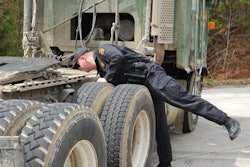Truckers looking for increasingly hard to find parking spaces may be getting some help from the American Transportation Research Institute (ATRI) and the U.S. Department of Transportation.
ATRI is working with multiple partners to test a new system for truck parking management, according to Dan Murray, ATRI’s vice president, who gave the keynote address at the Pegasus TransTech User Conference in Safety Harbor, Fla., on Wednesday, April 18.
When the system is widely deployed, a driver will be able to check on parking availability along an interstate corridor in real time using his own or a company-supplied wireless communication device.
One program which is nearly operational, Murray noted, was launched with the help of the Minnesota Department of Transportation and the University of Minnesota. It currently involves two public rest areas on I-94 in that state, and will expand to private truck stops within a few months. With several Wisconsin rest stops coming online later this year, the hope, Murray said, is that the system will ultimately extend the length of I-94, which runs 1,585 miles from Detroit, Mich., to Billings, Mont.
“Of course, the trucking industry would like to see it go national,” Murray said.
Murray outlined the parking initiative as part of his update on ATRI’s 2013 research activities for the customers of Pegasus TransTech, a provider of paperless transportation technology. Pegasus TransTech features prominent trucking personalities as keynote speakers at its annual user conferences. Last year’s speaker was American Trucking Associations’ President and CEO, Gov. Bill Graves.
Murray told the group that ATRI is guided by its Research Advisory Committee, which defines what they believe to be the most important issues confronting the trucking industry.
“This is the first time in a while that the economy has not been the committee’s top issue,” Murray said.
The top concern now is CSA (Compliance, Safety, Accountability), the Federal Motor Carrier Safety Administration’s comprehensive safety reporting and evaluation program. CSA is followed on the list by hours-of-service issues currently being argued in the courts. The economy is now in third place on the committee’s list followed by the driver shortage, Murray said.
While truck parking is not at the top of the list, it is a growing problem for drivers who are required by law to rest for certain periods of time. States have been closing public rest areas to save money, Murray explained. Meanwhile, time in some rest areas is limited and enforced by police, who also ticket drivers pulled over on entrance and exit ramps when no other space is available to them.
The problem will only get worse, Murray pointed out, as truck traffic increases.
The parking system being tested begins with cameras mounted at parking areas that send pictures of parking slots to a central server. The computer can tell whether or not a parking space is occupied and keeps a running, real-time inventory. In the future it is hoped this information will be available to drivers on the road as well as to dispatchers, who might use it to stage trailer exchanges, for example.













